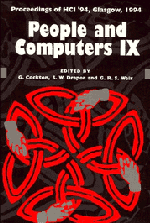Book contents
- Frontmatter
- Contents
- Preface: HCI'94 – You Probably Haven't Seen It All Before
- Part I Invited Papers
- Part II Methodology of Interactive Systems Development
- Crafting Interaction: Styles, Metaphors, Modalities and Agents
- Modelling Humans, Computers and their Interaction
- 18 Multi-Perspective Modelling of Interface Design Issues: Undo in a Collaborative Editor
- 19 Qualitative Models of User Interfaces
- 20 Modelling Interaction using Template Abstractions
- 21 The Formal Analysis of Human-Computer Interaction During Accident Investigations
- Notations and Tools for Design
- Part VI Computer-Supported Cooperative Work
- Author Index
- Keyword Index
18 - Multi-Perspective Modelling of Interface Design Issues: Undo in a Collaborative Editor
Published online by Cambridge University Press: 04 August 2010
- Frontmatter
- Contents
- Preface: HCI'94 – You Probably Haven't Seen It All Before
- Part I Invited Papers
- Part II Methodology of Interactive Systems Development
- Crafting Interaction: Styles, Metaphors, Modalities and Agents
- Modelling Humans, Computers and their Interaction
- 18 Multi-Perspective Modelling of Interface Design Issues: Undo in a Collaborative Editor
- 19 Qualitative Models of User Interfaces
- 20 Modelling Interaction using Template Abstractions
- 21 The Formal Analysis of Human-Computer Interaction During Accident Investigations
- Notations and Tools for Design
- Part VI Computer-Supported Cooperative Work
- Author Index
- Keyword Index
Summary
Successful interface design respects constraints stemming from a number of diverse domains analysed by different disciplines. Modelling techniques exist within the individual disciplines, but there is a need for ways to weave together different techniques to provide an integrated analysis of interface design issues from multiple perspectives. We illustrate the relations and interplay between six different modelling techniques — two for system modelling, two for user modelling, one for interaction modelling, and one for design modelling — applied to a shared design scenario concerning the provision of an Undo facility for a collaborative editor. The resulting multi-perspective analysis provides a depth of understanding and a breadth of scope beyond what can be achieved by any one technique alone.
Keywords: user modelling, system modelling, design rationale, interaction analysis, multi-disciplinary analysis, scenario analysis, undo, multi-user, editing.
Introduction
Successful interface design requires the satisfaction of a diverse set of constraints stemming from different domains. One of the factors making interface design so challenging is the number and diversity of those domains, and the different disciplines that study each. Relevant domains include that of the computer, within which are the disciplines of computer science and software engineering; of the user, studied by disciplines such as psychology; of work, the topic of sociology and anthropology and other disciplines; and of design itself.
Modelling techniques that can contribute to interface design exist in each of these domains. However, any one of these approaches tells only part of the story, and covers only some of the issues. There is a pressing need to combine modelling techniques derived from different disciplines and reflecting different perspectives in order to provide analyses with the scope and the depth adequate for guiding design.
- Type
- Chapter
- Information
- People and Computers , pp. 249 - 260Publisher: Cambridge University PressPrint publication year: 1994
- 1
- Cited by



